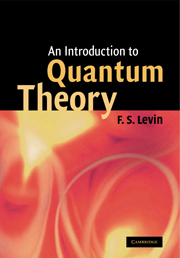Book contents
- Frontmatter
- Contents
- Preface
- PART I INTRODUCTORY
- PART II THE CENTRAL CONCEPTS
- PART III SYSTEMS WITH FEW DEGREES OF FREEDOM
- Chapter 10 Orbital Angular Momentum
- Chapter 11 Two-Particle Systems, Potential-Well Bound-State Problems
- Chapter 12 Electromagnetic Fields
- Chapter 13 Intrinsic Spin, Two-State Systems
- Chapter 14 Generalized Angular Momentum and the Coupling of Angular Momenta
- Chapter 15 Three-Dimensional Continuum States/Scattering
- PART IV COMPLEX SYSTEMS
- Appendix A Elements of Probability Theory
- Appendix B Fourier Series and Integrals
- Appendix C Solution of Legendre's Equation
- Appendix D Fundamental and Derived Quantities: Conversion Factors
- References
- Index
Chapter 13 - Intrinsic Spin, Two-State Systems
Published online by Cambridge University Press: 05 June 2012
- Frontmatter
- Contents
- Preface
- PART I INTRODUCTORY
- PART II THE CENTRAL CONCEPTS
- PART III SYSTEMS WITH FEW DEGREES OF FREEDOM
- Chapter 10 Orbital Angular Momentum
- Chapter 11 Two-Particle Systems, Potential-Well Bound-State Problems
- Chapter 12 Electromagnetic Fields
- Chapter 13 Intrinsic Spin, Two-State Systems
- Chapter 14 Generalized Angular Momentum and the Coupling of Angular Momenta
- Chapter 15 Three-Dimensional Continuum States/Scattering
- PART IV COMPLEX SYSTEMS
- Appendix A Elements of Probability Theory
- Appendix B Fourier Series and Integrals
- Appendix C Solution of Legendre's Equation
- Appendix D Fundamental and Derived Quantities: Conversion Factors
- References
- Index
Summary
Thus far we have concentrated on the postulates, on their ramifications, and on the means and methods by which they are applied. Connections with classical physics have been featured, and primary notions other than those of Chapter 5 have not been needed. We deviate from this path in the present chapter, introducing a new and extremely important concept; it is based on one of the most significant and fruitful experiments of the quantal era. This experiment was performed by O. Stern and W. Gerlach (1921) and subsequently interpreted by G. Uhlenbeck and S. Goudsmit (1925).
The experiment and its elucidation led to the new concept of “intrinsic spin” (in particular to spin “½”), a development that was one of the major turning points in modern physics. The consequences have been monumental, and include primary theoretical developments; the interpretation of data related to, and an understanding of, empirical rules concerning a wide variety of physical systems (e.g., the periodic table of the elements/atomic structure); and the generation of new experimental techniques and of innovative measurements. Our study of intrinsic spin and its correlative, two-state systems, introduces the reader to one of the most profound topics in quantum theory.
The Stern–Gerlach experiment and its interpretation
The experiment of Stern and Gerlach was designed to test the “spatial quantization” of neutral atoms, i.e., to determine whether the (orbital) angular momentum was quantized. The basic ideas are as follows. Associated with the atom's orbital angular momentum would be a magnetic moment, as in the Bohr model of hydrogen.
- Type
- Chapter
- Information
- An Introduction to Quantum Theory , pp. 487 - 516Publisher: Cambridge University PressPrint publication year: 2001



